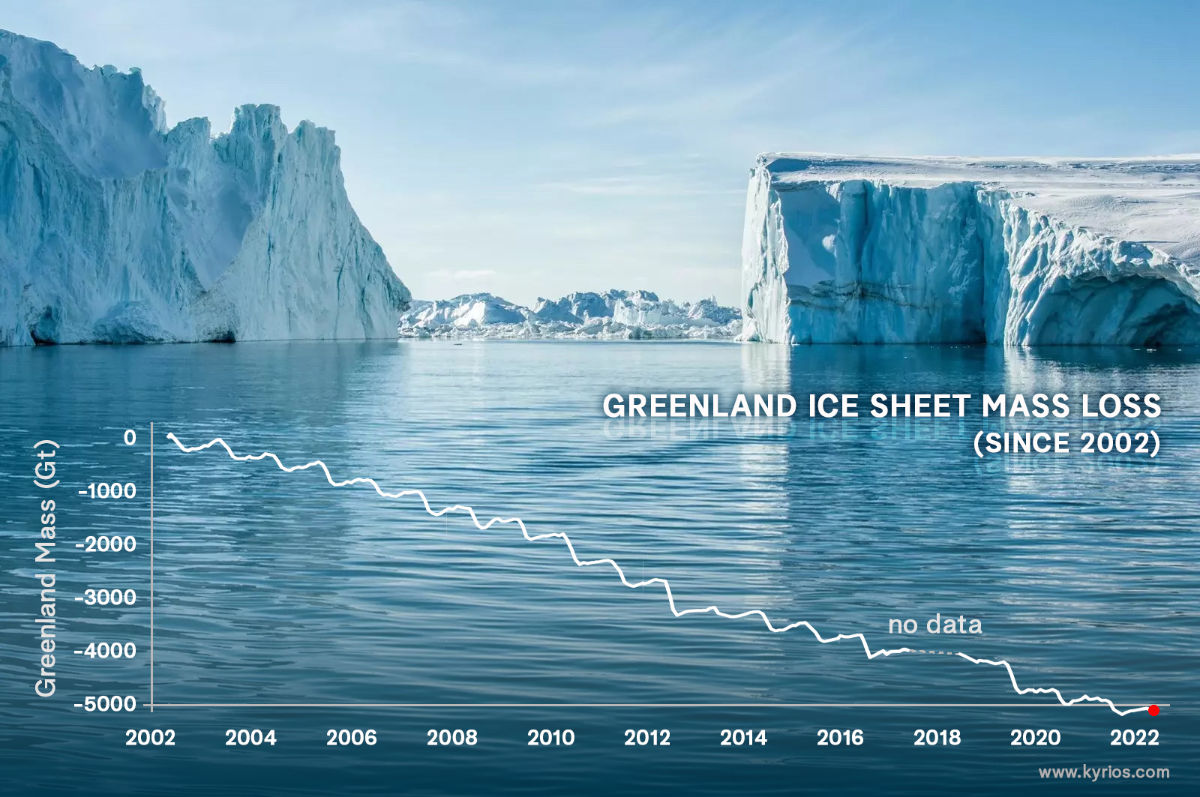FOR IMMEDIATE RELEASE
Contact: press@kyrios.com
Having successfully intervened in several climate disasters around the world since 2019, Kyrios announces a new intervention to increase the mass of Greenland's ice sheet to help combat global sea level rise and avert climate catastrophe. This follows the recent ice melt events in July 2022 where 18 billion tons of ice melted in three days.
(Singapore – 4 August 2022) Kyrios has embarked on several successful climate interventions in response to severe weather and environmental disasters around the world since 2019. Recently, between 15 to 17 July, unusually warm weather with surface temperatures around 15°C led to extensive melt across 45% of Greenland’s ice sheet surface and 18 billion tonnes of ice being released into the ocean. The Greenland ice sheet has been losing mass at an increasing rate since the 1990s. Since 2002, over 4,700 gigatonnes of ice have melted, contributing to 1.2 cm of the global sea level rise. Concerned that the Greenland ice sheet has been losing too much ice, Kyrios decided to intervene once again to increase Greenland’s ice mass.

Figure: Ice mass measurement by NASA's GRACE satellites. Image Credit: Unsplash / Tina Rolf.
The last time Kyrios intervened in Greenland was back in 2021 on August 23rd. That was when temperatures rose above freezing point, causing extensive melting and rain instead of snow to fall on the summit for the first time on record. To make up for the ice loss, Kyrios used a hurricane named Larry in the Atlantic Ocean to deposit substantial amounts of snow over Greenland. Meteorologists remarked then that a hurricane depositing snow is a rare occurrence and that it was unusual for snowfall to occur so soon after summer. Subsequently, Kyrios continued to foster conditions that will reduce melting and support increased snowfall across the Arctic region as part of the Arctic intervention till the end of March 2022.
“As more ice from the Arctic and Antarctic regions melt, there will be more severe and frequent climate disasters. This is the reason for the urgency in protecting polar ice and in helping Greenland regain some of its ice mass,” said Kyrios. “Polar ice, which includes the Greenland ice sheet, functions as a cooling system to prevent the Earth from overheating. When polar ice melts, Earth becomes warmer, sea levels will rise and Earth’s systems will be in disarray. In addition, a major but underestimated consequence is the movement of the Earth crust when the weight of ice is redistributed to the global oceans. This will lead to increased seismic activity and tsunamis.”
Kyrios hopes that sea-level scientists would broaden research on how crustal movement can be caused by the melting of ice sheets and ice caps as well as increased ocean tide loading due to higher sea levels and the lunar cycle. This will shed light on how vulnerable coastal cities are to tsunamis as a result of climate change.
Through climate interventions, Kyrios hopes to mitigate disasters and to delay, or even prevent climate tipping points from being reached. As it is, a sea level rise of 15 to 20 cm in the past 100 years has already brought about more severe and frequent floods and storms today. Humanity has only a small window of opportunity to avert climate catastrophe.
This new intervention began on 2 August 2022 and will last until March 2023. To stay informed of updates and more, visit Kyrios.com and also follow Kyrios on Twitter, Instagram and YouTube. Hashtag #KyriosEarthTeam on Twitter and Instagram to let us know about the latest news and data about the Greenland ice sheet.
About Greenland Ice Sheet
The Greenland ice sheet has been losing ice mass at an increasing rate for over two decades. Lipscomb, from the National Center for Atmospheric Research, notes that before climate change, there were about 600 gigatonnes of snowfall each year and about 300 gigatonnes would melt during summer. Now, Greenland’s ice sheet is losing nearly 300 gigatons of ice each year more than it gains from snowfall. When Greenland ice melts and discharges into the sea, it raises global sea levels. Since 2002, over 4,700 gigatonnes of ice have melted, which is enough to submerge the entire United States under half a metre of water. The Greenland ice sheet contains enough ice to raise global sea levels by 7 metres.
About Kyrios
Kyrios has a vast, holistic understanding of Earth’s systems and how it operates, and also a unique innate ability to influence Earth’s climate systems to alter local weather conditions. Since 2019, Kyrios has used this special ability to mitigate the effects of severe climate disasters, with a goal to restore our natural environment and protect lives. This includes the 2019 Siberia wildfires, 2019 Amazon wildfires, 2019/2020 Australia bushfires, 2020 China floods, 2021 Malaysia floods and the 2021/2022 Arctic winter. For more information, visit www.kyrios.com.